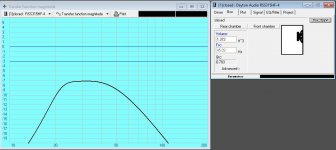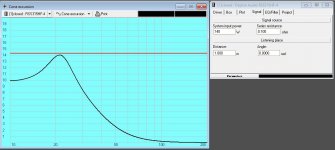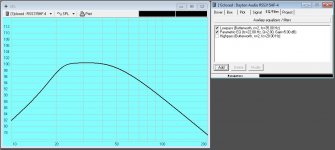Just to add context to why I suggested that link...The CSS SDX10 looks to be a really good subwoofer (although above your price range) but the recommended vented F3 is 27hz. But I can't imagine that F3 being inadequate for music. (yes, an F3 of 60 seems inadequate).
Also, keep in mind that it's not the case that it goes to zero below F3. I've seen some people claim that they care more about F6 or F10. (It looks like your pretty up to speed on all this, so I'm just trying to throw some suggestions out there.)
Also, keep in mind that it's not the case that it goes to zero below F3. I've seen some people claim that they care more about F6 or F10. (It looks like your pretty up to speed on all this, so I'm just trying to throw some suggestions out there.)
I certainly appreciate it and took it the way it was intended.
I will see what Christmas holds. Since we don't have kids we get pretty generous with each other; she has a big ole list of things I'm interested in and the RSS315HF-4 is on it. Currently out of stock but she could still order and let me know. If she did not, maybe I will change my mind.
Deciding on a driver has been a real pain in the butt - I have modeled about 40 different drivers from loads of manufacturers. Its my own fault because, I do not want big cabinets kicking around.
I will see what Christmas holds. Since we don't have kids we get pretty generous with each other; she has a big ole list of things I'm interested in and the RSS315HF-4 is on it. Currently out of stock but she could still order and let me know. If she did not, maybe I will change my mind.
Deciding on a driver has been a real pain in the butt - I have modeled about 40 different drivers from loads of manufacturers. Its my own fault because, I do not want big cabinets kicking around.
Hello:
I whole heartedly agree with you approach. I am following your thread with great interest. Any idea on the time line for these drivers coming back for sale? Where have you gotten with cabinet design and amplification.
Good for you, carry on, you are on the right path as far as I can figure out.
I whole heartedly agree with you approach. I am following your thread with great interest. Any idea on the time line for these drivers coming back for sale? Where have you gotten with cabinet design and amplification.
Good for you, carry on, you are on the right path as far as I can figure out.
I'd have thought multiple sub setups would need to be mono. Lets say your 'left' sub has a big dip at 50Hz which, when you add your 'right' sub to the room is evened out at listening position.
Now what happens if a bass guitar is panned to the left channel ? Suddenly the 50Hz dip appears again at listening position.
So yes, stereo subs will possibly sound different to mono multiple sub setups, almost like a variable EQ that cuts in and out according to the panning in the mix.
Just a thought.. 😀
Now what happens if a bass guitar is panned to the left channel ? Suddenly the 50Hz dip appears again at listening position.
So yes, stereo subs will possibly sound different to mono multiple sub setups, almost like a variable EQ that cuts in and out according to the panning in the mix.
Just a thought.. 😀
I'm a woodworker so I'll design and build my own cabinets.
Cabinet volume is determined by WinISD.
I will not start designing the cabinet until I have speakers in hand
I am using a Behringer NU1000DSP for amplification. Its stereo, built in crossover, high and low pass filtering, parametric eq, and loads of other features.
Summing bass to mono was common (Due to limitation of vinyl playback) until the advent of CD's, since then most bass remains stereo. When summing to mono we lose some of the stereo cues that place an instrument in the mix.
When you hear a loud bass heavy car drive by, do you question if its to the left or right? Nope. Those frequencies are reaching each ear at different times thus indicating direction. One could argue it is the upper frequencies indicating direction but scientists would argue otherwise to a point. A link provided by Andy C post to some scientific papers in regard to low frequency stereo imaging is further evidence. You can find the link at the bottom of this page: Stereo 10" sealed subs - UM10, RSS265HO-4, or RSS265HF4/8 - advice - AVS Forum | Home Theater Discussions And Reviews
To be completely fair, I have no idea is this is going to be good or bad, however, I am going to be armed with tools that take me out of the equation to some degree; calibrated mic and digital room correction.
If you are not familiar with DIRAC or digital room correction I highly advise you do some reading. When I first heard about it I poo poo'd it. I then listened to a $100k system prior to room correction and post room correction - the changes were astounding.
The software runs a series of frequency sweeps for each speaker and sub-woofer with the calibrated mic in the listening position. It also runs sweeps with all speakers to verify results. The software then calculates delay times per speaker (thus sub could be place 3' closer to the listener but time aligned by software), adjusts EQ per speaker to address room of cabinet resonances, modes, and room reflections. In my case my right speaker is 2' from a side wall while the left is 16' from a side wall - room correction will attempt to mitigate this issue.
In my case I am purchasing a NAD C 658 preamp/DAC with DIRAC built in to the hardware - I just need to purchase the license to use it. The NAD also has true stereo subwoofer output.
Cabinet volume is determined by WinISD.
I will not start designing the cabinet until I have speakers in hand
I am using a Behringer NU1000DSP for amplification. Its stereo, built in crossover, high and low pass filtering, parametric eq, and loads of other features.
Summing bass to mono was common (Due to limitation of vinyl playback) until the advent of CD's, since then most bass remains stereo. When summing to mono we lose some of the stereo cues that place an instrument in the mix.
When you hear a loud bass heavy car drive by, do you question if its to the left or right? Nope. Those frequencies are reaching each ear at different times thus indicating direction. One could argue it is the upper frequencies indicating direction but scientists would argue otherwise to a point. A link provided by Andy C post to some scientific papers in regard to low frequency stereo imaging is further evidence. You can find the link at the bottom of this page: Stereo 10" sealed subs - UM10, RSS265HO-4, or RSS265HF4/8 - advice - AVS Forum | Home Theater Discussions And Reviews
To be completely fair, I have no idea is this is going to be good or bad, however, I am going to be armed with tools that take me out of the equation to some degree; calibrated mic and digital room correction.
If you are not familiar with DIRAC or digital room correction I highly advise you do some reading. When I first heard about it I poo poo'd it. I then listened to a $100k system prior to room correction and post room correction - the changes were astounding.
The software runs a series of frequency sweeps for each speaker and sub-woofer with the calibrated mic in the listening position. It also runs sweeps with all speakers to verify results. The software then calculates delay times per speaker (thus sub could be place 3' closer to the listener but time aligned by software), adjusts EQ per speaker to address room of cabinet resonances, modes, and room reflections. In my case my right speaker is 2' from a side wall while the left is 16' from a side wall - room correction will attempt to mitigate this issue.
In my case I am purchasing a NAD C 658 preamp/DAC with DIRAC built in to the hardware - I just need to purchase the license to use it. The NAD also has true stereo subwoofer output.
What about a pair of the 10" Ultimax bundles on PE?
when I spoke with the parts express folks at Axpona then said the RSS subs are best for music. The ultimax are impressive but not meant for critical reproduction. That is the impression I got from them.
Also, in several forum posts I have been directed back to the RSS drivers for musical fidelity over the Ultimax series.
Have you checked out Rythmik servo sub drivers? Rythmik Audio • 12" servo subwoofer driver - DS1200
An older set of measurements can be found here: DIY Rythmik Audio Direct Servo 12" sealed 56L - Home Theater Forum and Systems - HomeTheaterShack.com
While I did not diy my Rythmik L12's, I have a pair integrated with my mains using Audiolense, which is similar to Dirac, but uses digital XO... I use these subs for critical listening to music - the servo tech to my ears produces a very musical sub. I wrote an article on it: Integrating Subwoofers with Stereo Mains using Audiolense - CA Academy - Computer Audiophile
Even though my JBL's have solid response to 40 Hz, and I listen mostly to rock, I digital XO'd the subs at 45 Hz and still amazed how much tight, musical low end comes out of the subs.
Good luck with your build and enjoy the bass extension!
An older set of measurements can be found here: DIY Rythmik Audio Direct Servo 12" sealed 56L - Home Theater Forum and Systems - HomeTheaterShack.com
While I did not diy my Rythmik L12's, I have a pair integrated with my mains using Audiolense, which is similar to Dirac, but uses digital XO... I use these subs for critical listening to music - the servo tech to my ears produces a very musical sub. I wrote an article on it: Integrating Subwoofers with Stereo Mains using Audiolense - CA Academy - Computer Audiophile
Even though my JBL's have solid response to 40 Hz, and I listen mostly to rock, I digital XO'd the subs at 45 Hz and still amazed how much tight, musical low end comes out of the subs.
Good luck with your build and enjoy the bass extension!
I have not checked out Rythmik. I looked for prices for the drivers, does not seem to exist. I sent them a message.
Have you checked out Rythmik servo sub drivers?
Rythmik would require I use their amplifiers and I already have an amp.
My wife did buy me a pair of Dayton RSS315HF-4 drivers for Christmas. I entered the numbers in WinISD and it spit out 1.372cf for a sealed cabinet. When accounting for driver displacement and other bits I get an internal dimension of:
11.5" deep
15" wide
15" tall
If something this small I wonder if I should even bother with internal bracing?
If so, would I be better off, ultimately, just to double the wall thickness on all sides instead of bracing?
11.5" deep
15" wide
15" tall
If something this small I wonder if I should even bother with internal bracing?
If so, would I be better off, ultimately, just to double the wall thickness on all sides instead of bracing?
Using decent 3/4" plywood, I might not bother bracing something that small, but a few cross braces would stiffen as much, or more than doubling the cabinet thickness with very little material and time spent.If something this small I wonder if I should even bother with internal bracing?
If so, would I be better off, ultimately, just to double the wall thickness on all sides instead of bracing?
Last edited:
Kinda where I am at with it, too.
Its not like I am going to pound the crap out of these things but no need to be foolish, either.
Its not like I am going to pound the crap out of these things but no need to be foolish, either.
1 to 1.5 cubic foot sealed box
Just curious,
What size of sealed box and what max SPL do the Dayton drivers sim at?
I have been looking at Beyma drivers and attached sims for a 12 inch and a 15 inch, plus a crazy 21 inch option I dont have space for!
LOW & MID FREQUENCY 15P1000Fe V2 | Beyma lists all Beyma drivers, they are good value at US Speakers.com
Thanks.
Alex.
Just curious,
What size of sealed box and what max SPL do the Dayton drivers sim at?
I have been looking at Beyma drivers and attached sims for a 12 inch and a 15 inch, plus a crazy 21 inch option I dont have space for!
LOW & MID FREQUENCY 15P1000Fe V2 | Beyma lists all Beyma drivers, they are good value at US Speakers.com
Thanks.
Alex.
Attachments
Remember, I am depending on a few things with this design decision:
1. There is very little music content below 30 hz, even less at 25 hz, and virtually nothing at 20 hz.
2. Any music content in the 20-30hz range will be very low in the mix, thus, even if I were listening at 100db I imagine those frequencies will be 3-6db lower, if not more.
3. I can always turn on a high pass filter at 20hz which will start rolling off at 25hz thus get more SPL without fear of over driving the sub.
The behringer NU1000dsp has high and low pass filtering available starting at 20hz.
Box is 1.372 cu ft (default size spit out by WinISD for sealed cab)
Crossover set at 35hz
Highpass filter = none
EQ Gain 5db @ 22hz Q2
35hz = 100db
25hz = 100db
20hz = 97db
Crossover set at 35hz
Highpass filter at 20hz Q2
EQ Gain 4db @25hz Q2.5
35hz = 102.9
25hz = 101
20hz = 95
Crossover set at 35hz
Highpass filter @ 25hz Q4
EQ Gain 3db @25hz Q2.5
35hz = 103.5
25hz = 101.4
20hz = 93.4
As you can see I have a few options to gain a bit of SPL and/or protect the drivers.
Images below are using the first set of settings above.
I would like to note, I am not sure I am using WinISD correctly. I would also not the values for this speaker from loudspeakerdatabase are incorrect.
Response
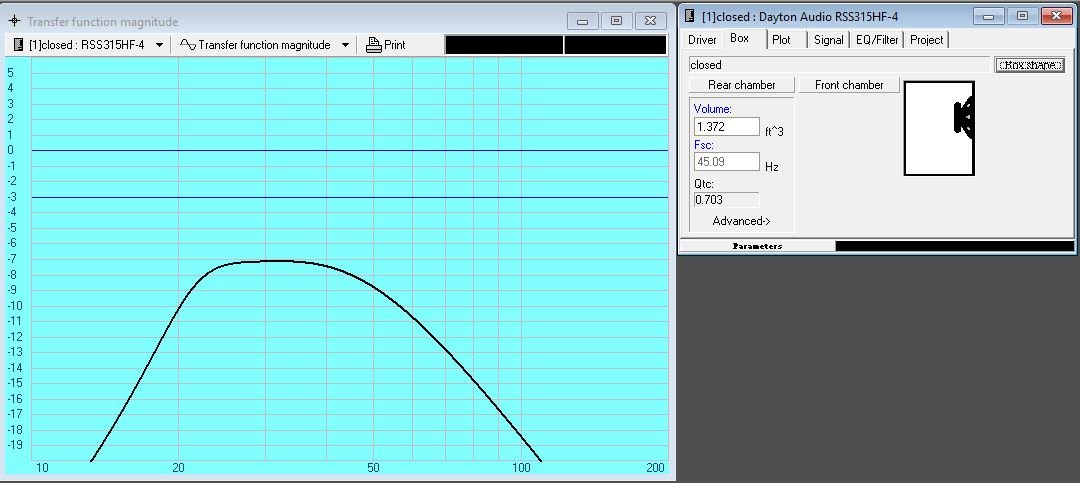
Excursion
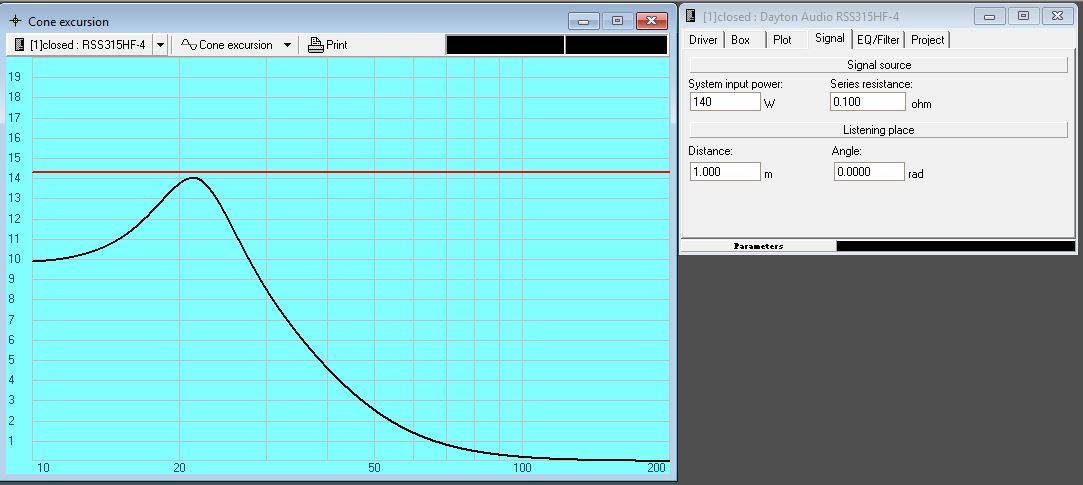
SPL
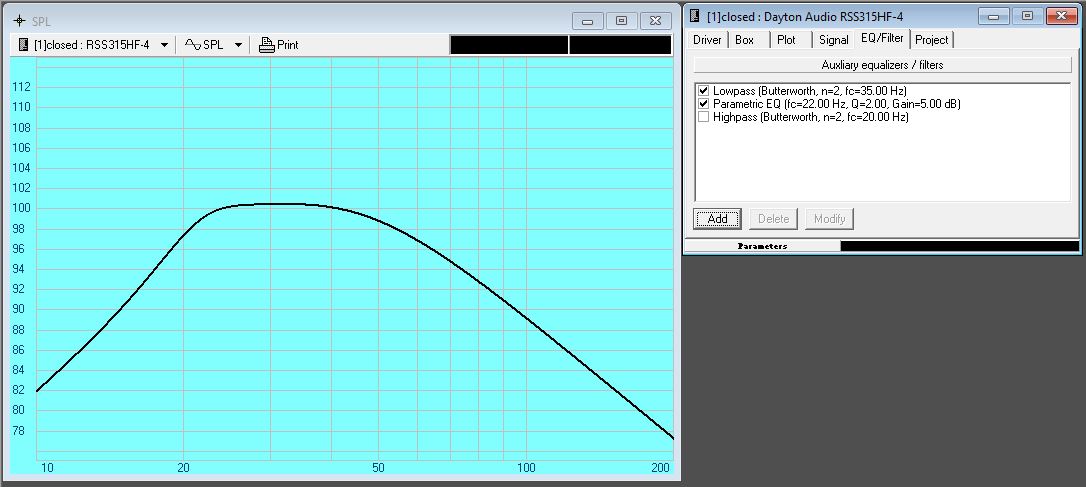
1. There is very little music content below 30 hz, even less at 25 hz, and virtually nothing at 20 hz.
2. Any music content in the 20-30hz range will be very low in the mix, thus, even if I were listening at 100db I imagine those frequencies will be 3-6db lower, if not more.
3. I can always turn on a high pass filter at 20hz which will start rolling off at 25hz thus get more SPL without fear of over driving the sub.
The behringer NU1000dsp has high and low pass filtering available starting at 20hz.
Box is 1.372 cu ft (default size spit out by WinISD for sealed cab)
Crossover set at 35hz
Highpass filter = none
EQ Gain 5db @ 22hz Q2
35hz = 100db
25hz = 100db
20hz = 97db
Crossover set at 35hz
Highpass filter at 20hz Q2
EQ Gain 4db @25hz Q2.5
35hz = 102.9
25hz = 101
20hz = 95
Crossover set at 35hz
Highpass filter @ 25hz Q4
EQ Gain 3db @25hz Q2.5
35hz = 103.5
25hz = 101.4
20hz = 93.4
As you can see I have a few options to gain a bit of SPL and/or protect the drivers.
Images below are using the first set of settings above.
I would like to note, I am not sure I am using WinISD correctly. I would also not the values for this speaker from loudspeakerdatabase are incorrect.
Response
Excursion
SPL
Attachments
Thanks, looks good to me.
I have never uses winISD but I will run a sim using AJ and the official Dayton spec.
Cheers
Alex.
I have never uses winISD but I will run a sim using AJ and the official Dayton spec.
Cheers
Alex.
RSS315HF-4 12" Reference HF Subwoofer 4 Ohm Specification Sheet
On the spec sheet Xmax is 14mm.
To be sure its apples Vs apples does Dayton measure Xmax as per the AES standard (ie like Beyma) or does it use the "point to point" like some audiophile manufacturers?
Also, power handling is quoted RMS, not AES, how do they compare? 65mm double layer voice coil should handle a fair bit of power?
The Beymas have 100mm voice coils.
On the spec sheet Xmax is 14mm.
To be sure its apples Vs apples does Dayton measure Xmax as per the AES standard (ie like Beyma) or does it use the "point to point" like some audiophile manufacturers?
Also, power handling is quoted RMS, not AES, how do they compare? 65mm double layer voice coil should handle a fair bit of power?
The Beymas have 100mm voice coils.
Last edited:
14mm and 7mm Xmax sims
Not sure about xmax so ran a sim with each.
101 and 106dB max spl at 30Hz depending on Xmax.
Needs a very big box compared to Beyma but only 400 watts Vs 700 watts with Beyma.
If you have the space it looks like they should work well, good luck.
Cheers
Alex.
Not sure about xmax so ran a sim with each.
101 and 106dB max spl at 30Hz depending on Xmax.
Needs a very big box compared to Beyma but only 400 watts Vs 700 watts with Beyma.
If you have the space it looks like they should work well, good luck.
Cheers
Alex.
Attachments
- Status
- Not open for further replies.
- Home
- Loudspeakers
- Subwoofers
- Pair of 10" or 12" subs - guidance please
